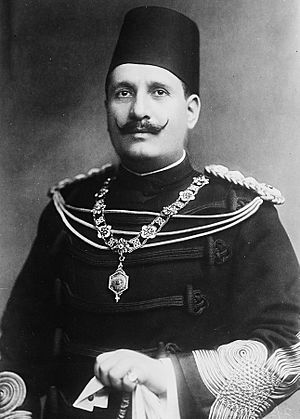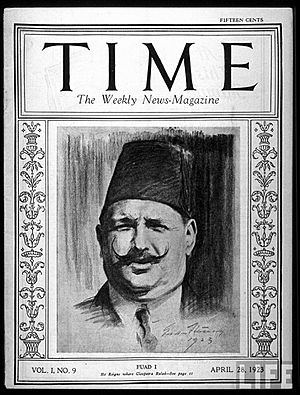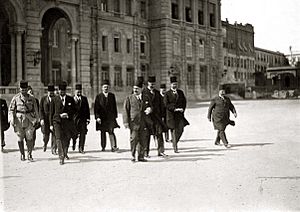Fuad I of Egypt facts for kids
Quick facts for kids Fuad Iفؤاد الأول |
|||||
|---|---|---|---|---|---|

Fuad in 1922
|
|||||
| King of Egypt and Sovereign of Nubia, the Sudan, Kordofan and Darfur | |||||
| Reign | 15 March 1922 – 28 April 1936 | ||||
| Predecessor | Himself as Sultan of Egypt | ||||
| Successor | Farouk I | ||||
| Prime Ministers |
See list
Abdel Khaliq Sarwat Pasha
Muhammad Tawfiq Nasim Pasha Yehya Ibrahim Pasha Saad Zaghloul Pasha Ahmad Ziwar Pasha Adli Yakan Pasha Mustafa el-Nahhas Pasha Muhammad Mahmoud Pasha Isma'il Sidqi Pasha Abdel Fattah Yahya Pasha Ali Mahir Pasha |
||||
| Sultan of Egypt | |||||
| Reign | 9 October 1917 – 15 March 1922 | ||||
| Predecessor | Hussein Kamel I | ||||
| Successor | Himself as King of Egypt | ||||
| Prime Ministers |
See list
Hussein Rushdi Pasha
Muhammad Said Pasha Youssef Wahba Pasha Muhammad Tawfiq Nasim Pasha Adli Yakan Pasha Abdel Khaliq Sarwat Pasha |
||||
| Born | 26 March 1868 Giza Palace, Cairo, Khedivate of Egypt, Ottoman Empire |
||||
| Died | 28 April 1936 (aged 68) Koubbeh Palace, Cairo, Kingdom of Egypt |
||||
| Burial | Al-Rifa'i Mosque, Cairo, Egypt | ||||
| Consort |
Shivakiar Ibrahim
(m. 1895; div. 1898)Nazli Sabri
(m. 1919) |
||||
| Issue | Prince Ismail Princess Fawkia Farouk I of Egypt Fawzia, Queen of Iran Princess Faiza Princess Faika Princess Fathia |
||||
|
|||||
| House | Alawiyya | ||||
| Father | Isma'il I | ||||
| Mother | Ferial Qadin | ||||
| Religion | Sunni Islam | ||||
Fuad I (Arabic: فؤاد الأول Fu’ād al-Awwal; Turkish: I. Fuad or Ahmed Fuad Paşa; 26 March 1868 – 28 April 1936) was the Sultan and later King of Egypt and the Sudan. The ninth ruler of Egypt and Sudan from the Muhammad Ali dynasty, he became Sultan in 1917, succeeding his elder brother Hussein Kamel. He replaced the title of Sultan with King when the United Kingdom unilaterally declared Egyptian independence in 1922.
Contents
Early life
Fuad was born in Giza Palace in Cairo, the fifth issue of Isma'il Pasha. He spent his childhood with his exiled father in Naples. He got his education from the military academy in Turin, Italy. His mother was Ferial Qadin.
Prior to becoming sultan, Fuad had played a major role in the establishment of Egyptian University. He became the university's first rector in 1908, and remained in the post until his resignation in 1913. He was succeeded as rector by then-minister of Justice Hussein Rushdi Pasha. In 1913, Fuad made unsuccessful attempts to secure the throne of Albania for himself, which had obtained its independence from the Ottoman Empire a year earlier. At the time, Egypt and Sudan was ruled by his nephew, Abbas II, and the likelihood of Fuad becoming the monarch in his own country seemed remote. This, and the fact that the Muhammad Ali dynasty was of Albanian descent, encouraged Fuad to seek the Albanian throne. Fuad also served as president of the Egyptian Geographic Society from 1915 until 1918.
Reign

Fuad came under consideration as a candidate for the Albanian throne, but he was ultimately bypassed in favour of a Christian ruler. He ascended the throne of the Sultanate of Egypt upon the death of his brother Hussein Kamel in 1917. In the aftermath of the Egyptian Revolution of 1919, the United Kingdom ended its protectorate over Egypt, and recognised it as a sovereign state on 28 February 1922. On 15 March 1922, Fuad issued a decree changing his title from Sultan of Egypt to King of Egypt. In 1930, he attempted to strengthen the power of the Crown by abrogating the 1923 Constitution and replacing it with a new constitution that limited the role of parliament to advisory status only. Large scale public dissatisfaction compelled him to restore the earlier constitution in 1935.
The 1923 Constitution granted Fuad vast powers. He made frequent use of his right to dissolve Parliament. During his reign, cabinets were dismissed at royal will, and parliaments never lasted for their full four-year term but were dissolved by decree.
Creation of the Royal Archives
Fuad was an instrumental force in modern Egyptian historiography. He employed numerous archivists to copy, translate, and arrange eighty-seven volumes of correspondence related to his paternal ancestors from European archives, and later to collect old documents from Egyptian archives into what became the Royal Archives in the 1930s. Fuad's efforts to portray his ancestors – especially his great-grandfather Muhammad Ali, his grandfather Ibrahim, and his father – as nationalists and benevolent monarchs would prove to be an enduring influence on Egyptian historiography.
Personal life
Fuad married his first wife in Cairo, on 30 May 1895 (nikah), and at the Abbasiya Palace in Cairo, on 14 February 1896 (zifaf), Princess Shivakiar Khanum Effendi (1876–1947). She was his first cousin once removed and the only daughter of Field Marshal Prince Ibrahim Fahmi Ahmad Pasha (his first cousin) by his first wife, Vijdan Navjuvan Khanum. They had two children, a son, Ismail Fuad, who died in infancy, and a daughter, Fawkia. Unhappily married, the couple divorced in 1898. During a dispute with the brother of his first wife, Prince Ahmad Saif-uddin Ibrahim Bey, Fuad was shot in the throat. He survived, but carried that scar the rest of his life.
Fuad married his second wife at the Bustan Palace in Cairo on 24 May 1919. She was Nazli Sabri (1894–1978), daughter of Abdu'r-Rahim Pasha Sabri, sometime Minister of Agriculture and Governor of Cairo, by his wife, Tawfika Khanum Sharif. Queen Nazli also was a maternal granddaughter of Major-General Muhammad Sharif Pasha, sometime Prime Minister and Minister for Foreign Affairs, and a great-granddaughter of Suleiman Pasha, a French officer in Napoleon's army who converted to Islam and reorganized the Egyptian army. The couple had five children, the future King Farouk, and four daughters, the Princesses Fawzia (who became Queen Consort of Iran), Faiza, Faika, and Fathia.
As with his first wife, Fuad's relation with his second wife was also stormy. The couple continually fought, Fuad even forbidding Nazli from leaving the palace. When Fuad died, it was said that the triumphant Nazli sold all of his clothes to a local used-clothes market in revenge. Fuad died at the Koubbeh Palace in Cairo and was buried at the Khedival Mausoleum in the ar-Rifai Mosque in Cairo.
King Fuad's wife lived as a widow after his death. She did not have good relations with her son. After Fuad's death, she left Egypt and went to the United States. She converted to Catholicism in 1950 and changed her name to Mary Elizabeth. She got deprived of her rights and titles in Egypt. Once named the world's richest and most elegant woman, she possessed one of the largest jewellery collections in the world.
China
The Fuad (Fū’ād) (فؤاد الأول) Muslim Library in China was named after him by the Chinese Muslim Ma Songting. Muḥammad 'Ibrāhīm Fulayfil (محمد إبراهيم فليفل) and Muḥammad ad-Dālī (محمد الدالي) were ordered to Beijing by the King.
Titles
- 26 March 1868 – 9 October 1917: His Highness Ahmed Fuad Pasha
- 9 October 1917 – 15 March 1922: His Highness The Sultan of Egypt and Sudan, Sovereign of Nubia, Kordofan and Darfur
- 15 March 1922 – 28 April 1936: His Majesty The King of Egypt and Sudan, Sovereign of Nubia, Kordofan and Darfur
Honours
- Domestic
- Founder and Sovereign of the Order of Agriculture
- Founder and Sovereign of the Order of Culture
- Founder and Sovereign of the Order of Commerce and Industry
- Foreign
- Ottoman Empire: Order of the Medjidie, 1st Class, 1893
- Kingdom of Italy: Grand Cross of the Order of Saints Maurice and Lazarus, 1911
- Greece: Grand Cross of the Order of the Redeemer, 1912
- United Kingdom of Great Britain and Ireland: Knight Grand Cross of the Order of the Bath (GCB), 1917
- Qajar Iran: Imperial Order of Persia, 1919
- Portugal: Grand Cross of the Order of the Tower and Sword, 1920
- Sweden: Commander Grand Cross of the Order of Vasa, 1921
- Kingdom of Romania: Grand Cross w/Collar of the Order of Carol I, 1921
- Empire of Japan: Collar of the Order of the Chrysanthemum, 1921
- Kingdom of Italy: Knight of the Order of the Most Holy Annunciation, 1922
- Spain: Collar of the Order of Charles III, 1922
- Kingdom of Hejaz: Grand Cordon of the Order of the Renaissance of the Hejaz, 1922
- Netherlands: Knight Grand Cross of the Order of the Netherlands Lion, 1925
- Kingdom of Afghanistan: Grand Collar of the Order of the Supreme Sun, 1927
- Albanian Kingdom: Grand Collar of the Kingdom of Albania, 1927
- United Kingdom: Royal Victorian Chain (RVC), 1927
- French Third Republic: Grand Cross of the Legion of Honour, 1927
- Belgium: Grand Cordon of the Order of Leopold, 1927
- Syria: Grand Cordon of the Order of the Umayyads, 1927
- Czechoslovakia: Collar of the Order of the White Lion, 1927
- Poland: Grand Cross of the Order of the White Eagle, 1932
- Sweden: Knight of the Royal Order of the Seraphim, 1933
- Thailand: Knight of the Order of the Royal House of Chakri, 1934
- Denmark: Knight of the Order of the Elephant, 1932
- Finland: Grand Cross of the Order of the White Rose of Finland, 1935
- Iran: Grand Collar of the Order of the Crown, 1935
See also
 In Spanish: Fuad I de Egipto para niños
In Spanish: Fuad I de Egipto para niños
- Kingdom of Egypt
- List of monarchs of the Muhammad Ali dynasty



